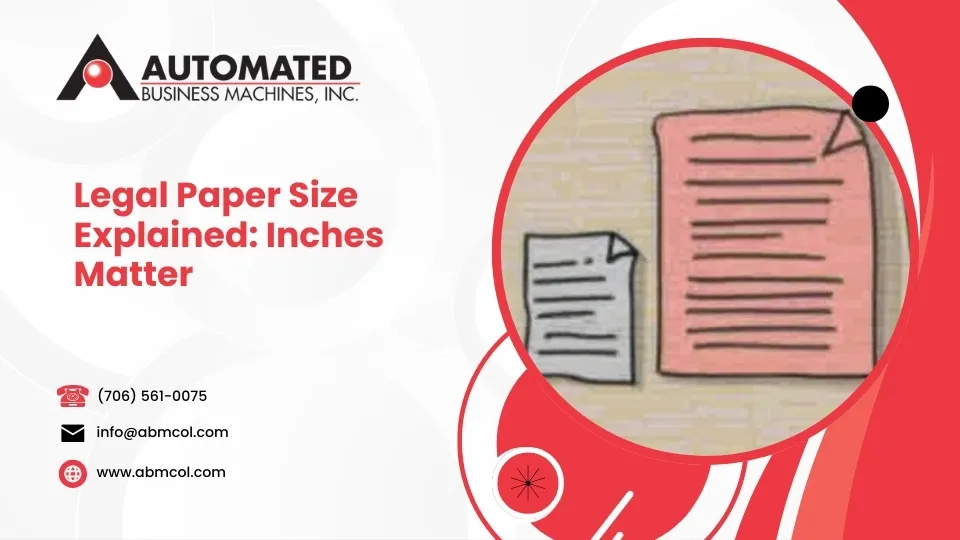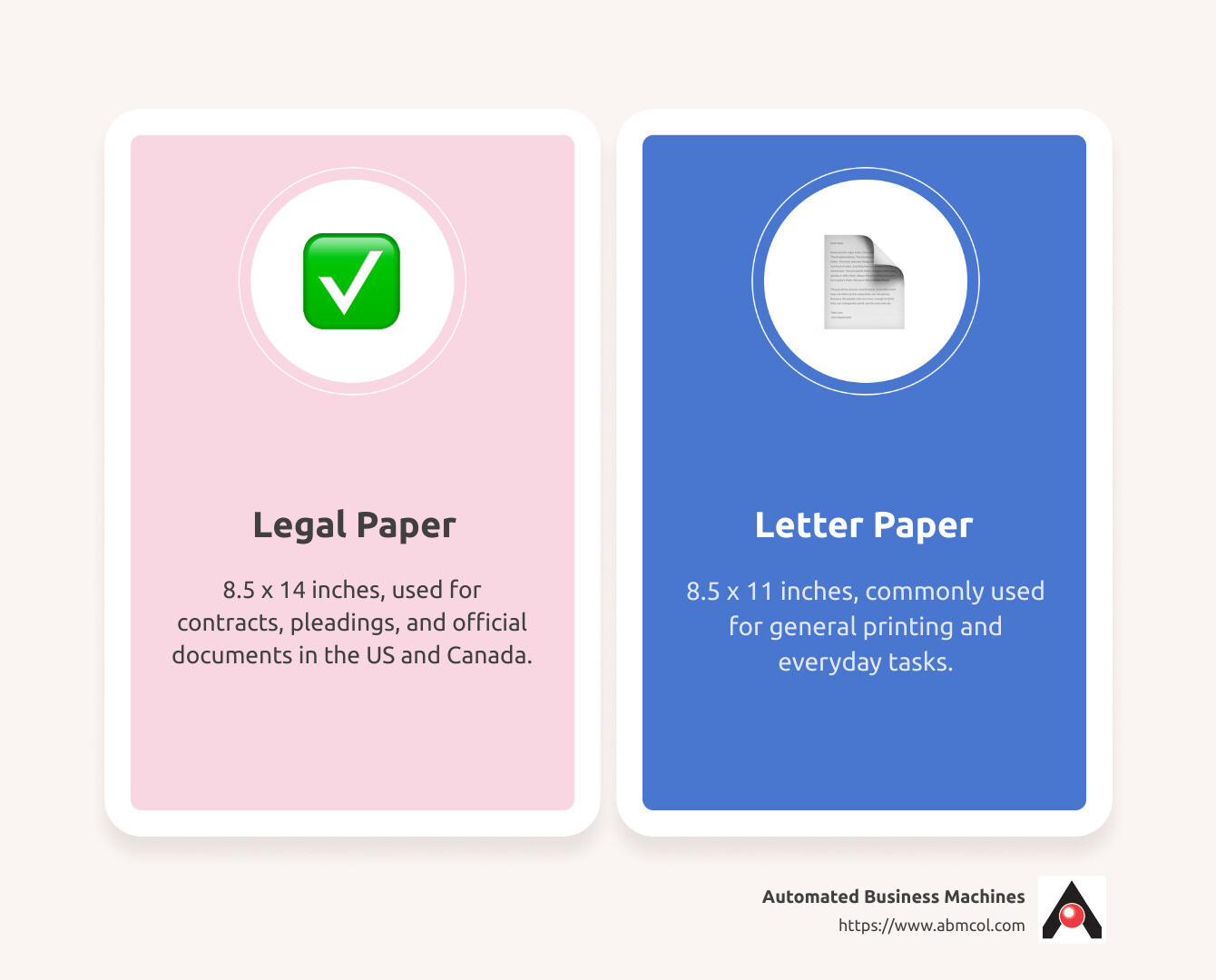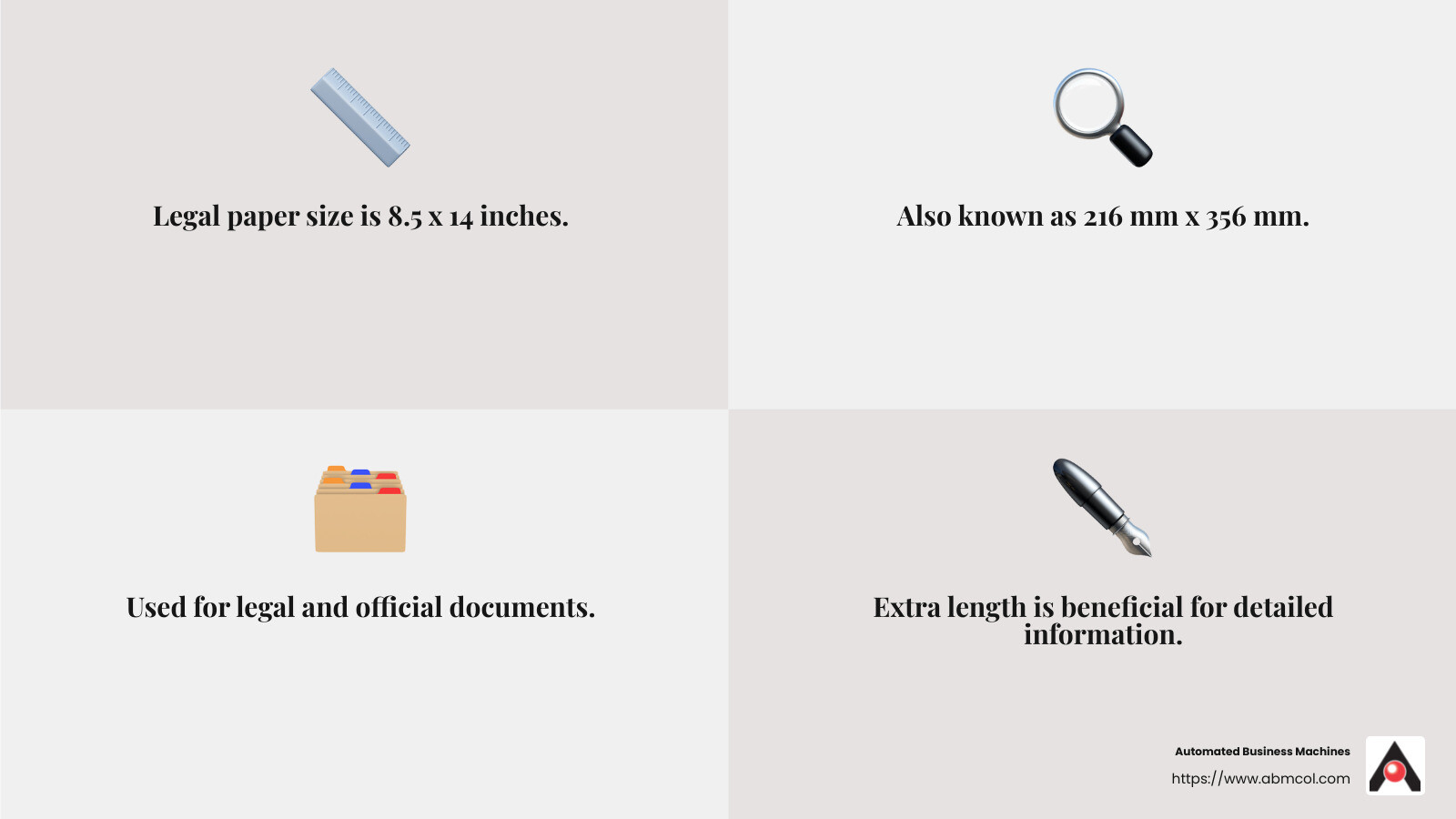
What is the legal paper size? It’s a question often posed by legal professionals, government employees, and anyone handling formal documents in North America. The answer is simple and crucial for those working with such papers on a regular basis: Legal printer paper measures 8.5 × 14 inches.
When every inch matters, this extra length compared to the more common letter size (8.5 × 11 inches) offers additional space for detailed clauses or multiple signatures. This is why legal paper is the staple for contracts, pleadings, and other official documents across the United States and Canada.
Understanding the dimensions and uses of legal paper is vital for anyone managing office printing solutions, especially in settings that prioritize precise document formatting. As business dynamics evolve, maintaining compatibility with this size paper ensures efficient operations and helps in adhering to legal standards.
With the right printing solutions, managing legal paper sizes can streamline processes, reduce costs, and increase productivity in any tech-focused office environment.
What Size is Legal Printer Paper?
When discussing what size is legal printer paper, remember that legal paper measures 8.5 x 14 inches. This size is fixed and recognized under ANSI standards, which are used across the United States and Canada for various legal and official documents.
Legal Paper Dimensions
The specific dimensions of legal paper are 216 mm x 356 mm. This size is standardized, meaning it doesn’t vary and is consistent wherever it is used. The extra length of legal paper compared to other sizes is particularly beneficial for documents that require more space for detailed information, such as contracts or legal filings.
Comparison with Other Paper Sizes
To put legal paper into perspective, let’s compare it with other common paper sizes:
- Letter Size: Measures 8.5 x 11 inches (215.9 mm x 279.4 mm). It’s the most common paper size for everyday use in North America, perfect for standard printing tasks but often lacking the space needed for more complex documents.
- A4 Size: Measures 8.3 x 11.7 inches (210 mm x 297 mm). This size is widely used internationally, especially in Europe and Asia, following the ISO 216 standard. While A4 is slightly narrower and longer than letter size, it still falls short of the length offered by legal paper.
The key difference lies in the extra length of legal paper, which provides more room for content without needing additional pages. This makes it a preferred choice in legal and governmental contexts where detailed information is crucial.
Understanding these differences can help businesses and individuals choose the right paper size for their specific needs, ensuring that documents are both functional and professional in appearance.
Importance of Legal Paper Size
In the legal industry, legal paper size plays a crucial role. Its extra length provides ample space for detailed clauses and multiple signatures, which are often necessary in legal documents. This added space helps in drafting complex contracts and agreements without the need for additional pages, maintaining a clean and professional look.
Why Legal Paper is Preferred
Legal professionals prefer legal size paper because it accommodates intricate legal terminology and detailed clauses. The extra length allows for more comprehensive documentation, which is essential for contracts that require clear and precise language. This is particularly useful in situations where numerous parties must sign the document, as the additional space ensures that all signatures fit neatly on the same page.
Moreover, the consistency of legal paper size across legal documents helps streamline the filing and processing of paperwork, making it easier for legal teams to manage large volumes of documents efficiently.
Legal Paper in Government Use
Legal paper is also widely used in government forms and official records. Its size is ideal for documents that require extensive information, such as real estate transactions and civil lawsuits. Government agencies often use legal paper to ensure that all necessary details are captured without compromising readability.
In real estate, for instance, legal paper is used to document property deeds and agreements. These documents often contain detailed descriptions and numerous signatures, making the extra space of legal paper invaluable. Similarly, in civil lawsuits, the additional room allows for comprehensive documentation of cases, ensuring that all relevant information is included.
Overall, the use of legal paper in government and legal settings provides a standardized format that facilitates clear communication and efficient record-keeping, ensuring that all parties have access to complete and accurate information.
Common Issues with Legal Paper Size
Printing on Legal Paper
Printing on legal paper size can be a bit tricky due to its unique dimensions. At 8.5 x 14 inches, legal paper is longer than the standard letter size, which is 8.5 x 11 inches. This difference often leads to compatibility issues with printers, as most are set to print on letter size by default.
Paper jams and misaligned prints are common problems when attempting to print legal documents without adjusting printer settings. If the printer isn’t set to accommodate the extra length of legal paper, it may struggle to feed the paper correctly, resulting in jams or incomplete prints.
Formatting challenges also arise when documents are not properly adjusted to fit the legal size dimensions. Text and margins may not align as intended, leading to a less professional appearance.
Solutions for Legal Paper Printing
To tackle these issues, adjust the printer settings before printing. Ensure that the default paper size is changed to 8.5 x 14 inches. Most printers have a simple menu option to make this adjustment. Additionally, formatting the document to match these dimensions will help avoid any misalignment issues.
For businesses that frequently work with legal documents, investing in multifunction printers designed to handle larger paper sizes can be beneficial. These printers are equipped to manage the extra length of legal paper without causing jams or compromising print quality.
Secure printing solutions can also improve the efficiency of handling legal documents. By implementing secure print features, sensitive information is protected, and only authorized personnel can access and print the documents. This is especially important in legal and government settings where confidentiality is paramount.
By addressing these common issues and utilizing the right equipment and settings, businesses can streamline the process of printing on legal paper, ensuring that all documents are produced accurately and professionally.
Frequently Asked Questions about Legal Paper Size
Is Legal Paper the Same as A4?
No, legal paper size and A4 are not the same. Legal paper measures 8.5 x 14 inches (216 mm x 356 mm), while A4 paper measures 8.3 x 11.7 inches (210 mm x 297 mm). The distinction is important, especially for those working across different countries. A4 is the standard in most of the world, following ISO 216 standards, whereas legal size is primarily used in North America.
This difference in size can lead to formatting challenges when exchanging documents internationally. Legal documents drafted on A4 paper might not fit properly on legal-sized paper without adjustments. It’s essential to be aware of these differences to avoid any misalignment or content cutoff issues.
Why is Legal Paper Size Used for Legal Documents?
Legal paper size is preferred in the legal industry due to its extra length. At 8.5 x 14 inches, it provides more space for detailed clauses, terms, and multiple signatures. This is crucial for contracts, deeds, and affidavits, which often require extensive information.
The American National Standards Institute (ANSI) established these dimensions to accommodate the needs of legal professionals. The additional length allows for more content on a single page, making documents easier to read and review. This efficiency is why legal paper remains the standard for legal documents, especially in North America.
What are Common Printing Issues with Legal Paper?
Printing on legal paper size can present several challenges. One of the most common issues is printer compatibility. Many printers are set to print on letter size by default, which can lead to paper jams and misaligned prints if not adjusted to accommodate the legal size.
Another issue is formatting. Documents not formatted for legal dimensions may have text and margins that don’t align properly. This can result in a less professional appearance and potentially important information being cut off.
To mitigate these issues, it’s crucial to adjust printer settings to 8.5 x 14 inches before printing. Additionally, formatting documents to match legal dimensions can prevent misalignment problems. For frequent users of legal paper, investing in multifunction printers designed for larger sizes can be beneficial, as they are less prone to jams and ensure high-quality prints.
Conclusion
At Automated Business Machines, we understand the unique challenges and needs associated with legal paper size. Our customized solutions are designed to improve productivity and streamline your workflow, especially for businesses that require frequent use of legal-sized documents.
Customized Solutions: We offer a range of multifunction printing solutions that are custom to handle legal paper size with ease. Our products ensure compatibility and reduce the risk of paper jams, providing seamless printing experiences. This customization helps in maintaining the integrity and professionalism of your documents.
Productivity Improvement: By utilizing our advanced technology solutions, you can focus more on your core business activities and less on printing hassles. Our secure printing and digital workflows improve efficiency, allowing you to manage legal documents with confidence and ease.
For businesses that rely on legal-sized documents, choosing the right printing solutions is crucial. At Automated Business Machines, our expertise in secure printing and digital workflows ensures that your operations run smoothly and efficiently.
Explore our legal paper size solutions to see how we can help you overcome printing challenges and boost productivity.


